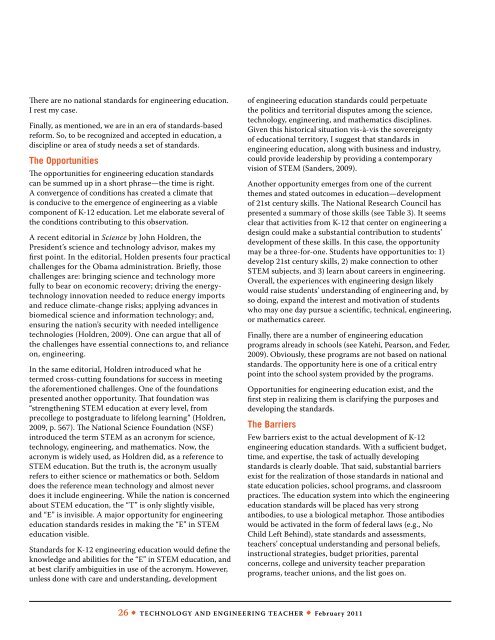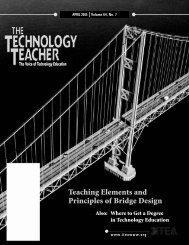K-12 Engineering Education Standards: - International Technology ...
K-12 Engineering Education Standards: - International Technology ...
K-12 Engineering Education Standards: - International Technology ...
You also want an ePaper? Increase the reach of your titles
YUMPU automatically turns print PDFs into web optimized ePapers that Google loves.
There are no national standards for engineering education.<br />
I rest my case.<br />
Finally, as mentioned, we are in an era of standards-based<br />
reform. So, to be recognized and accepted in education, a<br />
discipline or area of study needs a set of standards.<br />
The Opportunities<br />
The opportunities for engineering education standards<br />
can be summed up in a short phrase—the time is right.<br />
A convergence of conditions has created a climate that<br />
is conducive to the emergence of engineering as a viable<br />
component of K-<strong>12</strong> education. Let me elaborate several of<br />
the conditions contributing to this observation.<br />
A recent editorial in Science by John Holdren, the<br />
President’s science and technology advisor, makes my<br />
first point. In the editorial, Holden presents four practical<br />
challenges for the Obama administration. Briefly, those<br />
challenges are: bringing science and technology more<br />
fully to bear on economic recovery; driving the energytechnology<br />
innovation needed to reduce energy imports<br />
and reduce climate-change risks; applying advances in<br />
biomedical science and information technology; and,<br />
ensuring the nation’s security with needed intelligence<br />
technologies (Holdren, 2009). One can argue that all of<br />
the challenges have essential connections to, and reliance<br />
on, engineering.<br />
In the same editorial, Holdren introduced what he<br />
termed cross-cutting foundations for success in meeting<br />
the aforementioned challenges. One of the foundations<br />
presented another opportunity. That foundation was<br />
“strengthening STEM education at every level, from<br />
precollege to postgraduate to lifelong learning” (Holdren,<br />
2009, p. 567). The National Science Foundation (NSF)<br />
introduced the term STEM as an acronym for science,<br />
technology, engineering, and mathematics. Now, the<br />
acronym is widely used, as Holdren did, as a reference to<br />
STEM education. But the truth is, the acronym usually<br />
refers to either science or mathematics or both. Seldom<br />
does the reference mean technology and almost never<br />
does it include engineering. While the nation is concerned<br />
about STEM education, the “T” is only slightly visible,<br />
and “E” is invisible. A major opportunity for engineering<br />
education standards resides in making the “E” in STEM<br />
education visible.<br />
<strong>Standards</strong> for K-<strong>12</strong> engineering education would define the<br />
knowledge and abilities for the “E” in STEM education, and<br />
at best clarify ambiguities in use of the acronym. However,<br />
unless done with care and understanding, development<br />
of engineering education standards could perpetuate<br />
the politics and territorial disputes among the science,<br />
technology, engineering, and mathematics disciplines.<br />
Given this historical situation vis-à-vis the sovereignty<br />
of educational territory, I suggest that standards in<br />
engineering education, along with business and industry,<br />
could provide leadership by providing a contemporary<br />
vision of STEM (Sanders, 2009).<br />
Another opportunity emerges from one of the current<br />
themes and stated outcomes in education—development<br />
of 21st century skills. The National Research Council has<br />
presented a summary of those skills (see Table 3). It seems<br />
clear that activities from K-<strong>12</strong> that center on engineering a<br />
design could make a substantial contribution to students’<br />
development of these skills. In this case, the opportunity<br />
may be a three-for-one. Students have opportunities to: 1)<br />
develop 21st century skills, 2) make connection to other<br />
STEM subjects, and 3) learn about careers in engineering.<br />
Overall, the experiences with engineering design likely<br />
would raise students’ understanding of engineering and, by<br />
so doing, expand the interest and motivation of students<br />
who may one day pursue a scientific, technical, engineering,<br />
or mathematics career.<br />
Finally, there are a number of engineering education<br />
programs already in schools (see Katehi, Pearson, and Feder,<br />
2009). Obviously, these programs are not based on national<br />
standards. The opportunity here is one of a critical entry<br />
point into the school system provided by the programs.<br />
Opportunities for engineering education exist, and the<br />
first step in realizing them is clarifying the purposes and<br />
developing the standards.<br />
The Barriers<br />
Few barriers exist to the actual development of K-<strong>12</strong><br />
engineering education standards. With a sufficient budget,<br />
time, and expertise, the task of actually developing<br />
standards is clearly doable. That said, substantial barriers<br />
exist for the realization of those standards in national and<br />
state education policies, school programs, and classroom<br />
practices. The education system into which the engineering<br />
education standards will be placed has very strong<br />
antibodies, to use a biological metaphor. Those antibodies<br />
would be activated in the form of federal laws (e.g., No<br />
Child Left Behind), state standards and assessments,<br />
teachers’ conceptual understanding and personal beliefs,<br />
instructional strategies, budget priorities, parental<br />
concerns, college and university teacher preparation<br />
programs, teacher unions, and the list goes on.<br />
26 • <strong>Technology</strong> and <strong>Engineering</strong> Teacher • February 2011
















